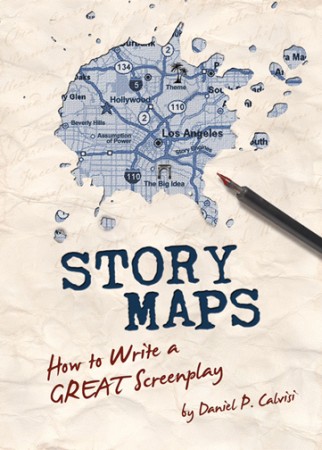Story Maps: How to Write a GREAT Screenplay
This exciting new screenwriting book is available now…
Excerpt from the Foreword of
Story Maps: How to Write a GREAT Screenplay:
This book is the culmination of over twenty years of working with screenplays and screenwriters. Reading, analyzing, evaluating, studying, teaching and coaching.
And, of course, writing. But it may interest you to know that although I am a professional screenwriter, I feel that writing is the second most important educational tool for learning the craft. The first is written analysis of screenplays and movies, the good ones and the bad ones.
I learned this on the job working in the movie industry for years as a Story Analyst for many top studios and production companies and from working one-on-one with screenwriters, both amateur and professional.
Over a period of years, I developed the Story Map method of structural analysis, which can be used to construct a new narrative or deconstruct an existing one. I discovered the importance of not just hitting page points, but using what I call Active Storytelling, which is making your scenes and your characters’ actions advance the story and bring about change while maintaining a cohesion built on theme and escalating conflict.
The purpose of the book is simple. To help you improve your craft and increase your odds of getting your script to impress a decision-maker in Hollywood. That’s it.
This method is not a guarantee of success, or a way to sidestep the hard work of developing your voice on the page. It’s a comprehensive working method that has guided hundreds of writers to craft their best work, and I’m excited and proud to bring it to you.
Buy the E-Book and Booster Pack now!
There’s tons of books on screenwriting. So why this one? Here’s some reasons why I think this book is needed:
- It’s from the perspective of the person on the other side of the desk that evaluates your material. No matter where you’re at in your career or who you know, you still need to blow away the reader, so I’m going to show you the best and most focused way to emulate the many successful scripts and movies that I’ve studied for over two decades.
- My structure system applies to every genre and the beats are always in the same order. There is no mixing and matching, order changes, or needless categorizing as with other systems. My method is stripped down to the practical essentials – let’s leave the theory and the journal entries and the pats on the back behind — I’m preparing you for the market to get past brutal readers like myself.
- All of the advice and guidelines in this book are based on the current, model spec screenplay in Hollywood. Lean, mean and fast-paced, this is not your uncle’s screenplay — this is not a winking holdover from the “Boom-Boom” 80s and 90s (you know, when they were handing out spec deals at LAX?). This 100-110 page cinematic emotion machine has a very clear and clean set of guidelines, qualities and standards, some of which can be broken, but only if you’ve mastered them first.
- This is much more than a beat sheet and outlines of popular movies. This book goes into depth about how to do it. How to write elegant description, use white space on the page, how to Show, not tell, and much more. These are topics that I don’t see covered in most screenwriting books.
- All of the advice (and the quotations, which you’ll find in the “From The Trenches” interstitial sections) comes from my direct experience with working professionals in the movie industry. If I quote a source (other than Billy Wilder, R.I.P.) then it’s because I personally spoke with them or was in the room when they spoke. These are bits of wisdom I’ve gathered from living and working in Los Angeles and New York City and talking with these individuals, in person.
You may have read other books written by screenwriters or lecturers or academics.
This book is different.
I’m going to strip it down.
I’m going to be tough on you.
I’m going to show you many examples from produced screenplays written by top professionals.
I’m going to keep this book short and to the point, with all the fat trimmed and focused only on the crucial information.
Just like I like my scripts.
Most importantly, the book will help you to develop your craft to take it to the crucial tier that you need to be: the “submission ready” level of quality that is the only way to blow away the reader.
Buy the E-Book and Booster Pack now!
Good Luck and Happy Writing!
Daniel Calvisi
Related: Read more about Booster Pack #1 that includes Full Story Maps of 12 hit movies
Related: FREE Sample Story Map download: The Wrestler
Related: FREE Story Map sample download: Sex and the City movie



Hey Dan! I saw some of your videos and read a lot from you!
I really want to read this book! When does it come out??
Your story map e-book is great man. I was stunned how many of the oscar nominated original screenplays kept to your models to a T.
Thanks, Shash! Yes, it’s amazing how much the structures of most commercial movies adhere to the Story Map, yet they are truly unique in their story decisions.
For those who say this is “cookie-cutter” movie making, I say, you’re right if you consider Million Dollar Baby, Sideways, Transformers and The Hangover to be all cut from the same mold! Because they all follow the Full Story Map and yet they couldn’t be more different. 🙂
Awesome cover!